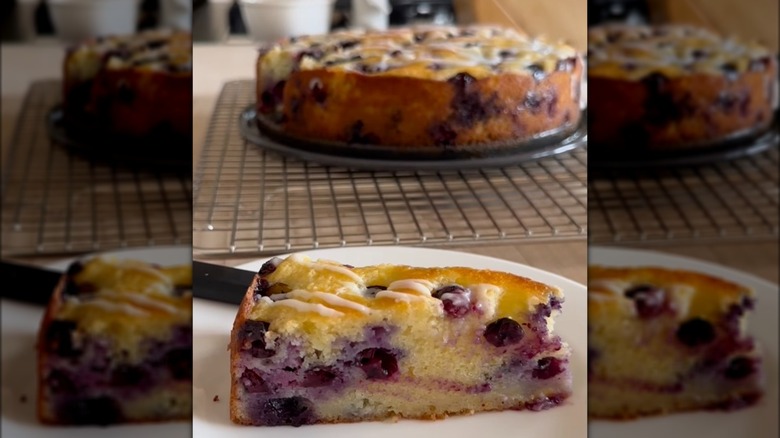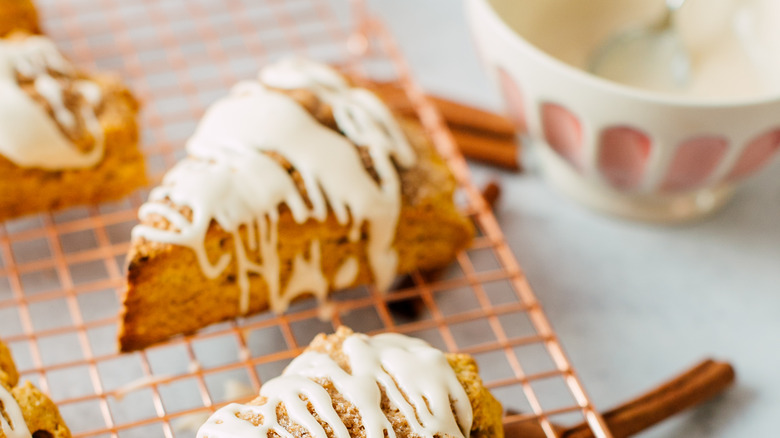How Ina Garten Makes Her Breakfast Cakes So Dreamy
After reading this story headline, if it left you saying, "You had me at cake for breakfast," you're not alone. It's really why brunch was invented — who couldn't use a little morning indulgence to start the day? Breakfast cakes are delectable sweet treats that taste great straight from the oven, yet Ina Garten takes hers to the next level with an additional step.
When preparing recipes like her blueberry ricotta breakfast cake, Garten adds a drizzle of vanilla glaze to make the baked good even more decadent. In under five minutes and with only two ingredients, Garten whips up this simple icing to use on cakes, cookies, muffins, and any slightly sweet dessert she wants to dress up.
To make it, Garten takes 1 cup of confectioners' sugar and the seeds from a vanilla bean, and adds just 1 tablespoon of tap water to yield ¼-cup of vanilla glaze. It's that simple. You can also adjust the glaze's consistency by adding additional drops of water until it's smooth and pourable. Then channel your inner Jackson Pollock and get creative.
Tips for preparing a vanilla glaze
There are a few tips to keep in mind before getting started making Ina Garten's vanilla glaze. First, when working with confectioners', powdered, or icing sugar, it's important to sift it first. Confectioners' sugar is a very fine powder, and it tends to cake from the slightest bit of moisture. So, if your sugar canister isn't airtight, you might end up with pea-size clumps. And starting with lumpy sugar can make it challenging to create a smooth consistency, especially if you plan on putting the glaze in a pastry bag. Therefore, it's always a good idea to take a minute and sift it first.
If you don't have any on hand, you can also make powdered sugar at home. Just pulse 1 cup of granulated sugar with 1 tablespoon of cornstarch in a food processor until it's ground into a fine powder (this will take just a few minutes).
Garten's vanilla glaze recipe calls for vanilla beans, but you can substitute them with pure vanilla extract or paste. A teaspoon of vanilla extract or vanilla bean paste will give you the same flavor as half a vanilla bean. However, if you're using extract, you'll need less water to reach the desired consistency of the glaze.
The glaze dries quickly, so don't prepare it too far in advance. Wait until the cake has cooled before whisking the ingredients together. If you get pulled away during the process, place a damp paper towel over the bowl to keep the glaze moist and prevent the surface from getting hard.
Tips for applying your glaze to sweet treats
Applying a glaze too early can be a mistake. You'll want to allow your breakfast cake to cool first so the icing doesn't melt on the surface and disappear. If you plan on freezing the cake, it's best to wait until it's thawed and ready to serve before adding the glaze for a better presentation.
If decorating makes you anxious, you don't need a pastry bag to achieve the same effect as Ina Garten. Instead, you can apply vanilla glaze with a fork or spoon for an attractive rustic look on desserts. To avoid large blobs, hold the icing a few inches above the dessert and start to drizzle from this height, moving quickly in a random pattern. Overlap your design if you are looking for a thicker glaze.
Decorating with icing is a great way to make store-bought goodies appear homemade, too. Purchase plain sugar, shortbread, or molasses cookies and add a personal touch by dipping or drizzling on homemade vanilla glaze. You can add the topping to muffins, pies, scones, and Sunday morning pancakes to make everything a little sweeter. And, mix a little food coloring to change the color or lemon zest for brightness. You can even vary the liquid in the recipe to adjust the consistency and flavor, substituting milk, apple cider, or pure maple syrup for different results. The wet glaze acts like glue to hold sprinkles, nuts, and other small garnishes, too.



